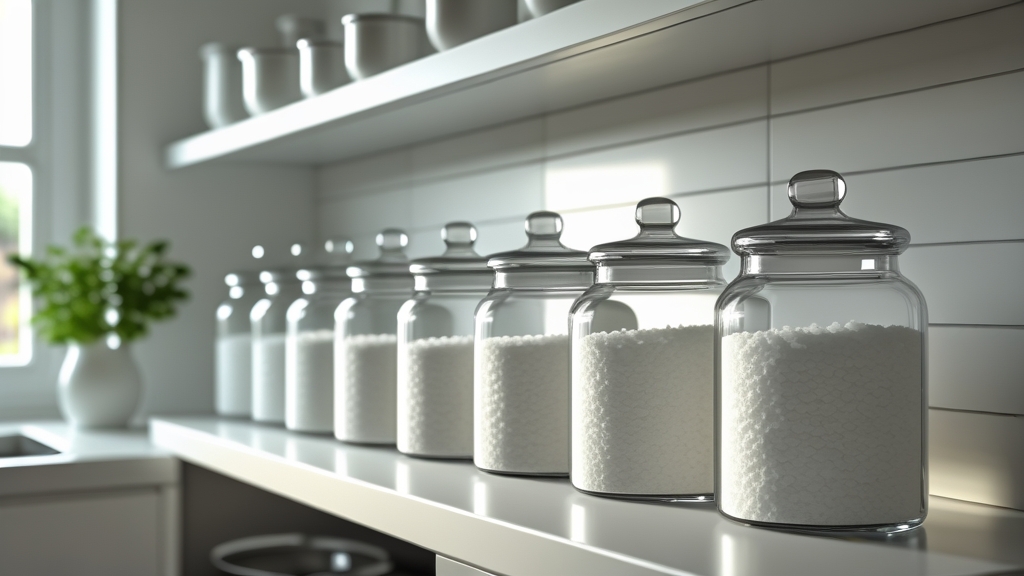How to Store Sea Salt and Keep It Fresh (No Clumps, No Waste)
Written By Santa Prisca & Co Staff Last updated on
How to Store Sea Salt and Keep It Fresh (No Clumps, No Waste)

7 Genius Secrets to Store Sea Salt and Keep It Fresh: No Clumps, No Waste!
Amazed by the idea of never having clumpy, wasted sea salt again? Dive into these unconventional yet practical secrets that will change the way you store your sea salt forever!
Key Points
- Importance of Proper Sea Salt Storage
- Common Mistakes
- Best Containers
- Tips to Prevent Clumping
- How to Revive Clumpy Salt
- Minimizing Waste
Importance of Proper Sea Salt Storage
Storing sea salt properly is very important for home cooks and small food businesses. When stored correctly, sea salt remains pure, tasting exactly as you expect it to and free of clumps. Most kitchen enthusiasts have learned that even a tiny bit of moisture can cause salt to become sticky and hard to use. This simple fact can change how you organize your pantry and even affect your cooking.
Common Mistakes in Sea Salt Storage
Many people make common mistakes when trying to keep sea salt free of clumps. One error is exposing salt to moisture, which is a natural enemy; the hygroscopic nature makes it absorb water from its surroundings. Another common blunder is using wrong storage materials such as metal containers which can corrode and mix unwanted flavors into the salt itself. Additionally, not sealing the container properly leaves the salt vulnerable to contaminants and odors in your kitchen.
Best Containers to Keep Your Sea Salt Fresh
Finding the best salt containers is key to keeping your sea salt fresh and clump-free. It is recommended to use airtight containers that prevent any moisture from seeping in, such as glass jars or food-grade plastic containers. These containers act as a barrier to keep the sea salt in an optimal, dry environment. Some home chefs also use ceramic or clay containers that are sealed with plastic lids for an extra layer of protection.
Tips to Prevent Clumping and Minimize Waste
- Keep It Dry: Always store your sea salt in a dry place. Add a few uncooked grains of rice in the container to absorb any excess moisture.
- Seal It Tightly: Make sure your containers are sealed properly every time you use them. A tight seal prevents not only moisture but also unwanted contaminants from getting in.
- Divide and Conquer: Use small containers if you purchase sea salt in large quantities. Label your containers with the date of storage to ensure you use the oldest first.
- Revive Clumpy Salt: If salt clumps, revive it by heating in a low-temperature oven (around 150°F - 200°F) for about 10-15 minutes, or use a mortar and pestle to grind it back to its original texture.

Avoiding the Pitfalls: Practical Do's and Don'ts
- Do Use Airtight Containers: Opt for containers that are airtight and made of materials that aren’t prone to corrosion. Glass is a favorite because it doesn’t interact with salt.
- Don’t Store Salt Near Heat: Keeping your sea salt near a stove or any heat source can introduce unwanted moisture and cause clumping.
- Do Keep Your Storage Area Clean: A clean, well-maintained pantry helps keep your sea salt free of contaminants and moisture.
- Don’t Mix Different Types of Salt: Store different salts separately to maintain their individual properties and prevent clumping or flavor changes.
Quick FAQ
Q: Why does my sea salt clump?
A: Sea salt clumps due to its hygroscopic nature, meaning it naturally attracts moisture from the air. Even a small amount of humidity can start the clumping process, which is why storing it in an airtight container is critical.
Q: How can I revive salt that has become clumpy?
A: You can revive clumpy sea salt by gently heating it in a low-temperature oven for 10-15 minutes, or by using a mortar and pestle to grind it down to a fine balance.
Q: Are there any specific containers recommended for salt storage?
A: Yes, the best containers are those that are airtight and made of non-reactive materials, like glass or certain plastics. These containers prevent moisture and odors from affecting the salt, thus maintaining its purity and usability.
Share your own tricks and tips in the comments and join the conversation.
Innovative Storage: A Continuous Journey
Our modern culinary world is full of opportunities to enhance even the simplest tasks. Storing sea salt may seem like a small detail, but it is a great example of how a modest ingredient can require smart and thoughtful management. By using airtight containers, avoiding exposure to heat and moisture, and separating your salts properly, you can ensure that every meal you prepare tastes just right.
Have you learned a new trick today to store sea salt better? Let us know in the comments below and take a step closer to achieving the best kitchen storage tips ever!

